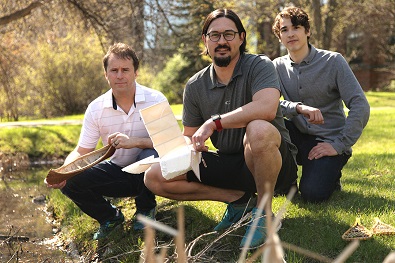U of S professor Sean Maw, Indigenous Peoples initiatives co-ordinator Matthew Dunn and engineering undergraduate Connor Theoret. Photo courtesy University of Saskatchewan.
The University of Saskatchewan has received $147,474 to promote engineering with Indigenous youths by finding innovative designs in their own back yards.
A three-year investment will allow two College of Engineering students to visit First Nations in the province to learn about local Indigenous designs that kids can connect with: for example, trap making.
The university wants to get Indigenous youth thinking about careers in engineering, because they’re currently underrepresented in the field, said Matthew Dunn, Indigenous Peoples initiatives co-ordinator at the College of Engineering. Dunn is an Alberta Dene man who got into the field with his eyes originally set on being an aerospace engineer.
“This project is a great way to get out into communities and talk to students about engineering, about opportunities in engineering, and then also to showcase and really celebrate examples of Indigenous technology and design,” he said.
The college will then use those technologies to develop hands-on teaching modules that could end up being distributed across Canada.
Dunn is a part of that module-building team, along with engineering professor and Jerry G. Huff Chair in Innovative Teaching Sean Maw.
Dunn said it’s important to engage with communities in a respectful manner.
“I’m sure there will be a few examples we’ll be able to find from books or other material, but we want to make sure a lot of our content is coming directly from communities, from Elders and knowledge keepers and community members,” he said.
The program will be called “Ancestral Engineering Design Activities,” and the first part of developing it will include a visit to Mistawasis First Nation this summer.
In a news release, Maw said they want to get Indigenous youth thinking about careers in engineering.
“The knowledge that their ancestors were excellent designers can instill pride and curiosity,” he said.
This is all made possible through a federal grant from the Natural Sciences and Engineering Research Council of Canada (NSERC). On Friday, more than $6.1 million in NSERC investments were announced by Kate Young, Canada’s Parliamentary Secretary for Science.
The lessons will end up as a part of a number of the U of S’s programs for youths, including summer camps and the science ambassadors who spend about a month in rural and remote Indigenous community schools.
